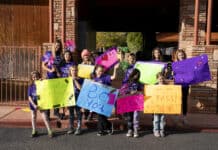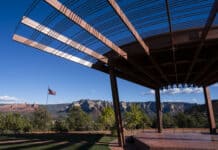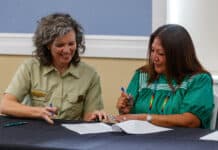I received a phone call last Wednesday from a former Sedona City Council member giving me a tip about a peace march planned for Saturday.
The “pro-love, peace, joy, beauty” “dance march and rally” began at an Uptown coffee shop and ended at a West Sedona health food store.
Based on the urgency of the call, I assumed that this former elected public servant was organizing or at least participating in this march and was requesting coverage from one of our reporters or photojournalists.
When I asked, the former council member gave me a definitive “no.” Instead, the nature of the call was to warn me that he and others were worried about the potential for violence at the peace march.
Violence at a small-town peace march seems counter-productive. Also, the statistical probability for violence at a event that ends where one can buy kale is near zero. My surprise was in the suggestion that Sedona residents would engage in a violent confrontation with others or police, especially after seeing the printed invitation, emblazoned with a big, red heart.
All that not withstanding, I asked the former official if he planned on attending to speak with the marchers to hear their concerns. If he disagreed with their political positions, I asked if he would perhaps instead try to find common ground, after all, as a former member of Sedona City Council tasked with serving the entirety of the city, not simply one faction, who better to build bridges?
To my knowledge, the only act of politically-related physical violence in recent memory involved two men who engaged in fisticuffs at a Village of Oak Creek forum discussing the proposed Sedona Verde Valley Red Rock National Monument. That conflict, however, was less about the issue and more about the individuals with a beef.
We have seen heated public debates over the monument, the installation of street lights on State Route 89A, the change out of analog power meters for smart meters and the proposed closure of Big Park Community School, all of which led to flared tempers, but none which rose to the level of indiscriminate nor targeted violence.
The First Amendment to the Constitution explicitly protects “the right of the people peaceably to assemble, and to petition the government for a redress of grievances.” The Founders understood that if government or its officials fail to serve and if the people have no guarantees to safely gather and show their displeasure in hopes of change, the next step is armed rebellion, because they had lived through just that in response to King George III’s treatment of the Colonies. Protests are release valves for an angry populace, but demonstrate a sine qua non failure of government to serve to the needs of the people, whether minority or majority.
Whether they agree or disagree, government leaders must — and fellow Americans should — see a constitutionally-protected peaceful protest not as a potential police action, but as an opportunity to meet with their constituents and neighbors to find compromises to assuage those complaints while also preserving the rule of law and the rights of all.
Our government was not designed to Balkanize our ideas into majority over minority, but to be one of compromise for the general public good. Just as a protest is a failure if no one is swayed by what protestors have to say, it is also a failure if the general public or opponents refuse to listen.
First Amendment to the Constitution of the United States
“Congress shall make no law respecting an establishment of religion, or prohibiting the free exercise thereof; or abridging the freedom of speech, or of the press; or the right of the people peaceably to assemble, and to petition the government for a redress of grievances.”
— submitted for ratification Sept. 25, 1789, and adopted Dec. 15, 1791
U.S. Supreme Court ruled in United States v. Cruikshank (1876), that assembling could not be banned by the federal government and by extention the states:
“The right of the people peaceably to assemble for the purpose of petitioning Congress for a redress of grievances, or for anything else connected with the powers or the duties of the National Government, is an attribute of national citizenship, and, as such, under the protection of, and guaranteed by, the United States.”
In Hague v. Committee for Industrial Organization (1939), the U.S. Supreme Court ruled that labor union meetings, and by extention all protests and demonstrations, could not be banned on public lands [specifically parks in Jersey City, N.J.], so long as they were peaceful and did not infringe on the rights of other members of the public to use those same rights-of-way:
“The privilege of a citizen of the United States to use the streets and parks for communication of views on national questions may be regulated in the interest of all; it is not absolute, but relative, and must be exercised in subordination to the general comfort and convenience, and in consonance with peace and good order; but it must not, in the guise of regulation, be abridged or denied.”



















